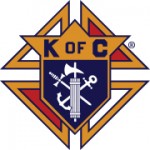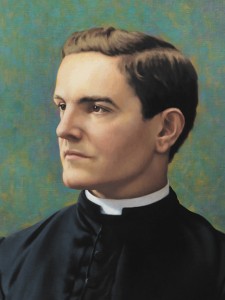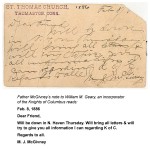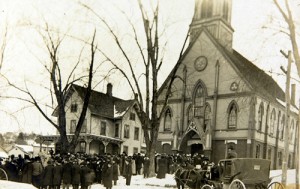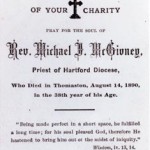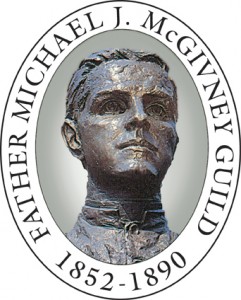At any Catholic ceremony of note, the Knights of Columbus are hard to miss. Lining the nave of the church or cathedral, swords drawn, plumed admiral’s hats much in evidence, they lend a touch of exotic splendor to any occasion. In many parishes they are known also for their charitable works on a local level, from fundraising for the parish or various worthy causes, to balls and bingo nights. But behind them is an impressive history, for all that the Order has been around for less than a century and a half.
The United States in the late 19th century was not an easy place to be a Catholic. Socially, the America of that time was filled with fraternal bodies such as the various branches of Masonry, the Oddfellows, the Knights of Pythias and the like, in whom membership was forbidden to members of the Church — and yet who often dominated things on a local level. There were (and are) Catholic ethnic fraternal groups such as the Catholic Central Verein, Ancient Order of Hibernians, the Association Canado-Americaine, and the Sons of Italy who gave their members many of the same benefits as the forbidden groups. But their very nature reinforced the view of non-Catholic Americans that the Faith was foreign — silly at best, dangerous at worst. What was lacking was a Catholic fraternal organization that would cut across ethnic lines, allow Catholics to reinforce their national institutions without surrendering their religion, and give them a strong social and political voice. In 1882, a young Irish-American priest — only four years out of seminary and merely a curate at St. Mary’s Church, New Haven — attempted to fill that gap. His name was Ven. Fr. Michael McGivney , and in that year he founded the Knights of Columbus.
Michael McGivney was born on August 12, 1852 in Waterbury, Connecticut. At the age of 16 he enrolled in the Seminaire St. Hyacinthe, a minor seminary in Quebec (secularized in 1970, it is now called the Collège Antoine-Girouard). Passing successive through Niagara University and St. Mary’s Seminary (and after a break of a few years occasioned by the needs of his family after his father’s death), he was ordained by Archbishop Gibbons of Baltimore in 1877. He was assigned to the parish of St. Mary’s New Haven.
At that time, the parishioners were mostly Irish and working class. Subject to severe discrimination, alcoholism was rife among them. In addition to his normal duties, the new curate was given the task of prison chaplain, which brought him into direct contact with many of the social ills facing his flock. He was also active with the young people of the parish, organizing catechism classes and a total abstinence society. Fr. McGivney, realizing the place that fraternalism held in American life, conceived the idea of forming a Catholic mutual benefit society that would both aid its members when in financial distress (especially after the death of a loved one) and give them an alternative to joining the existing non- and anti-Catholic ones. In 1881, he received permission from the Bishop of Hartford to explore erecting such a society.
Others had had the same idea elsewhere. In Worcester, Massachusetts, in 1879, members of the local St. Vincent de Paul Society, concerned by the same evils Fr. McGivney was facing in New Haven, cast about for a method of dealing with them. The pattern they found most appealing was that of the Independent Order of Foresters, itself a descendant of several English groups, ultimately originating in the 18th century among the poor working men of the rapidly industrializing Midlands. Bereft of any kind of social aid from their employers or the government, they banded together, taking inspiration from Robin Hood’s Merry Men — who had taken to the forest to provide mutual support. The English Foresters had invented a Medieval origin and involved ritual for themselves on the pattern of (and in rivalry with) the Freemasons, who at that time appealed exclusively to the better off. The result of the St. Vincent de Paul members’ efforts was the Catholic Order of Foresters in Massachusetts. This would inspire other groups, and in 1883 a national organization would be formed, which endures to the preset day as a life insurance company.
The same year Fr. McGivney turned his attention to the idea, a similar group in Brooklyn, the Catholic Benevolent Legion was founded. Fr. McGivney visited both Worcester and Brooklyn for inspiration, and on the night of February 7, 1882 gathered 24 men for the first meeting of the Knights of Columbus (ironically, while the Catholic Foresters remains, the Catholic Legion would merge with the Knights in 1969). Fr. McGivney wanted to call the new group the “Sons of Columbus,” invoking the name of the Catholic discoverer of the New World to show that Catholicism and American Patriotism could march hand-in-hand. Those members of the organization who had served in the Civil War suggested “Knights,” suggesting that the spirit and rituals of chivalry could help mobilize the membership not only in mutual support but in the higher goal of securing more civil liberty for Catholics and benefiting the nation as a whole thereby. On March 29, the Connecticut State legislature chartered the group.
Initially, the Knight’s principles were “Union” and “Charity;” “Fraternity” and “Patriotism” were added later. Each of them were (and are) the dominant themes in the Order’s ritual. In April he secured the Bishop’s support, and urged each pastor to install a council in their parish in order to prevent their flocks from joining secret societies which offered benefits at the price of faith. By 1885, there were 31 councils in the state.
The previous year, Fr. McGivney had been assigned as pastor to the debt-ridden, rundown parish of St. Thomas, Thomaston. Pursing his new position with same energy he had shown as a curate, he pulled the church out of the red while continuing to work on expanding the Order. As Supreme Chaplain, he personally oversaw the Knights’ expansion into Rhode Island. All of this exertion took its toll, and the frail young priest died of pneumonia in 1890. Due to his heroic virtue, his cause for canonization was opened, and Fr. McGivney was named “Venerable” in 2008.
The organization survived him, however. Its unique life insurance plan and other benefits, as well as it providing its members a source of civic pride, led to phenomenal growth in a relatively short period of time. By 1912, 20,000 knights were able to come to Washington to participate in the dedication of the Columbus Memorial. So fearful did this growth make some members of the Protestant establishment that in 1912 a phony “Knights of Columbus Oath,” describing in lurid terms each 4th degree knight’s supposed obligation to “exterminate heretics and Freemasons.” In response a congressman read the real oath into the Congressional Record. The knights mounted an education campaign, sending lecturers around the United States to inform the public as to the Church and the Order’s authentic stand on the issues.
When the United States entered World War I in 1917, the Knights rallied behind the war effort, opening up recreation centers, welcome huts, and information centers free of charge to the soldiers who used them. The result was the entrance of 400,000 returning soldiers; famous Dodger Babe Ruth joined in 1920. During the racial unrest of the 1920s, the Order at the national level issued the “Racial Contribution” series, amongst other things publishing the work of W.E.B. Dubois. A number of local councils, however, maintained an unofficial policy of segregation: at the time the Knights operated under the “blackball” system, whereby any single member could block the entrance of a candidate into a council for any reason whatsoever.
During the 1920s also, the anti-Catholic policies of the anti-Catholic Mexican government — heavily dependent on U.S. aid — led to a revolt of the nation’s faithful called the Cristero rebellion. The Order had spread to Mexico by that time. Six of its members were martyred by the government and later canonized; a seventh, Bishop Rafael Guízar Valencia, was driven out of his diocese, and forced to spend the conflict hiding out in Mexico City. Renowned for his work at that time among the downtrodden, he earned the nickname of “Bishop of the Poor,” and was made a saint in 2006. But the knights’ efforts to prevail upon Washington to moderate its support of the regime or use its influence to end the persecution met with little success. At last, the United States did manage to force its allies in Mexico to the peace table, but did nothing to make them abide by the agreement with the Cristeros when it was reached. The result was the slaughter of many of them afterwards.
On the internal front during that period, the Order scored innumerable successes in its campaign to defeat the widespread movement to ban parochial schools; this came closest t success with the passage of the Oregon School Bill in 1922. But thanks in great part to the Order’s educational work, the law was struck down by the Supreme Court in 1925, and the Catholic Schools reopened.
Three years later, though, the bogus oath resurfaced during the 1928 Presidential campaign as part of the successful effort to defeat Al Smith. Again, the knights swung into action — this time unsuccessfully. But the boom of the 1920s was succeeded by the Great Depression. Despite the fall off in membership, the insurance program weathered the storm where many similar programs failed. Local Councils were active in Church relief efforts as well. The knights successfully lobbied many States to declare Columbus Day a holiday, culminating in President Roosevelt’s extending it to the entire nation in 1937.
World War II saw the Order reprise its role in the first conflict. In addition to seconding the efforts of the National Catholic Welfare Conference for servicemen, the Order supported blood drives, war bond sales, and the like. The return of peace, however, brought a whole new set of challenges.
The onset of the Cold War following the fall of large stretches of Europe and Asia to Communism saw the Order mount large-scale educational programs in anti-Communism and Patriotism. In 1954, the knights’ lobbying was instrumental in Congress adding “Under God” to the Pledge of Allegiance, an effort for which they were officially thanked by President Eisenhower. By the end of the decade, Supreme Knight Luke Hart was urging councils that did not do so to accept black members. In 1964, the Supreme Convention abolished the blackball, requiring a third of council members to reject a candidate; in 1972 the rule was revised further — henceforth a majority of the membership would have to vote against a candidacy. In the election of 1960, although the Order did not endorse JFK, they did campaign against the anti-Catholicism that accompanied the campaign. With Kennedy’s victory, the old anti-Catholicism was spent as an open political force.
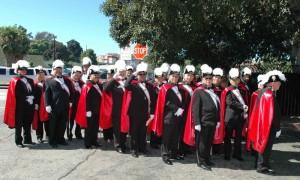
Members of the Knights of Columbus Fourth Degree Color Guard preparing for the Queen of Angels Foundation's First Annual Grand Marion Procession on September 3, 2011
But the 1960s and 70s saw the beginning of a new kind. Up until this period, the vast majority of Americans of whatever religion possessed a common set of values. But beginning with the legalization of artificial birth control by the Supreme Court in 1965, that moral consensus shattered. As the years wore on, and successive judicial and legislative actions took the nation and its states ever further away from Church teaching and the natural law, the Catholic Church emerged (alongside such ever more marginalized groups as Evangelicals, Mormons, Orthodox Jews) as one of the few defenders of what had been the universally recognized standards of civilized life. A new anti-Catholicism arose on the ruins of the old — smoother and more “enlightened,” but as nasty as its predecessor. This process continues today.
In that struggle, alongside its still-continuing fraternal, educational, and charitable endeavors, the Order has remained in the first rank. Although continuing to avoid advocating or opposing particular candidates, they have struggled to keep before the public eye the Church’s teaching on everything from moral issues to (as the seasonal billboards say) “keeping Christ in Christmas” — not only in the United States, but in all the countries to which they have spread: Mexico, Canada, the Bahamas, the Philippines, the Dominican Republic, and elsewhere. Moreover, the success of the Knights inspired similar although independent organizations in the British Isles, Australia, New Zealand, South Africa, Ghana, Nigeria, and other places — all of which are members of the International Alliance of Catholic Knights, an NGO numbering 36 similar bodies, and headquartered in Rome’s Palace of San Callisto.
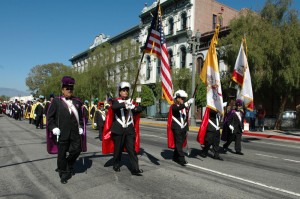
Members of the Knights of Columbus Fourth Degree Color Guard Marching in the Queen of Angels Foundation's First Annual Grand Marion Procession
Regarding strictly religious affairs, the Knights have raised millions for domestic churches, the Holy See, seminary scholarships, and many other such efforts. In 2009, the Order gave 151 million dollars, and members spent 69 million man hours on charitable causes. Membership has blossomed to over a million and a half, and innumerable Catholic and other causes have benefited from their assistance. Booth the Daughters of Isabella and the Catholic Daughters of the Americas owe their origins to women’s auxiliaries of K of C councils.
The Knights of Columbus and its brother organizations around the world, despite their names, are not knightly orders in the sense that the Order of Malta is, and make no claim to be. But in their devotion to the Church and their fellow man, each incarnates in its own way the spirit of Chivalry. Something to reflect on, when looking at their uniforms.
GENERAL
Knights of Columbus (Wikipedia)
http://en.wikipedia.org/wiki/Knights_of_Columbus
Knights of Columbus Supreme Website
http://www.kofc.org/en//index.html
Fr. Michael J. McGivney Guild
http://www.fathermcgivney.org/en/index.html
Knights of Columbus Museum, New Haven
http://www.kofcmuseum.org/en/index.html
Knights of Columbus Building, New Haven
http://www.greatbuildings.com/buildings/Knights_of_Columbus_Bldg.html
St. Mary’s Church, New Haven
http://www.kofc.org/un/en/about/history/stmarys.html
http://www.stmarys-priory.com/
Knights of Columbus Activities
http://www.kofc.org/un/en/about/activities/index.html
United in Charity
http://www.kofc.org/un/en/charities/index.html
Culture of Life Fund
http://www.kofc.org/un/en/charities/lifefund/index.html
Scholarships
http://www.kofc.org/un/en/scholarships/index.html
Knights of Columbus Insurance
http://www.kofc.org/un/en/insurance/index.html
Catholic Information Service
http://www.kofc.org/un/en/cis/index.html
Public Policy Issues
http://www.kofc.org/un/en/news/legislative/index.html
Knights in Action
http://www.kofc.org/en/knightsinaction/monthly_report/201105.htm
Catholic Daughters of the Americas
http://www.catholicdaughters.org/
Daughters of Isabella
http://www.daughtersofisabella.org/main.asp
UNITED STATES
ALABAMA
Knights of Columbus Alabama State Council
http://kofc-alabama.org/
ALASKA
Knights of Columbus Alaska State Council
http://www.alaska-kofc.org/statehome.htm
ARKANSAS
Knights of Columbus Arkansas State Council
http://www.arkofc.net/
CALIFORNIA
Knights of Columbus California State Council
https://www.kofc-ca.org
COLORADO
Knights of Columbus Colorado State Council
http://www.coloradokofc.org/
CONNECTICUT
Knights of Columbus Connecticut State Council
http://www.kofc-ct-state.org/Home.html
DELAWARE
Knights of Columbus Delaware State Council
http://www.de-kofc.org/
DISTRICT OF COLUMBIA
Knights of Columbus District of Columbia State Council
http://www.dcknights.org/
FLORIDA
Knights of Columbus Florida State Council
http://www.floridastatecouncil.com/viewpage.php?page_id=92
GEORGIA
Knights of Columbus Georgia State Council
http://www.gakofc.org/
GUAM AND THE NORTHERN MARIANAS
Knights of Columbus Guam and the Northern Marianas State Council
http://www.oocities.org/guam_knights/
HAWAII
Knights of Columbus Hawaii State Council
http://hawaii-knightsofcolumbus.com/
IDAHO
Knights of Columbus Idaho State Council
http://idkofc.com/
ILLINOIS
Knights of Columbus Illinois State Council
http://www.illinoisknights.org/mary/
INDIANA
Knights of Columbus Indiana State Council
http://www.indianakofc.org/
Knights of Columbus Building, Gary
http://en.wikipedia.org/wiki/Knights_of_Columbus_Building_(Gary,_Indiana)
Knights of Columbus-Indiana Club, South Bend
http://en.wikipedia.org/wiki/Knights_of_Columbus-Indiana_Club
IOWA
Knights of Columbus Iowa State Council
http://www.iowakofc.org/
KANSAS
Knights of Columbus Kansas State Council
http://www.kansas-kofc.org/
KENTUCKY
Knights of Columbus Kentucky State Council
http://www.kykofc.com/
LOUISIANA
Knights of Columbus Louisiana State Council
http://www.louisianakc.org/
MAINE
Knights of Columbus Maine State Council
http://www.maineknights.org/
MARYLAND
Knights of Columbus Maryland State Council
http://www.kofc-md.org/
MASSACHUSETTS
Knights of Columbus Massachusetts State Council
http://www.massachusettsstatekofc.org/
MINNESOTA
Knights of Columbus Minnesota State Council
http://www.mnknights.org/
MISSISSIPPI
Knights of Columbus Mississippi State Council
http://www.kofc-ms.org/
Knights of Columbus Hall, Pascagoula
http://en.wikipedia.org/wiki/Knights_of_Columbus_Hall_(Pascagoula,_Mississippi)
MISSOURI
Knights of Columbus Missouri State Council
http://www.mokofc.org/
MONTANA
Knights of Columbus Montana State Council
http://www.montanaknights.org/
Knights of Columbus Hall, Butte
http://montanahistorywiki.pbworks.com/w/page/28763513/Butte%20Historic%20District%20-%20Park%20Street%20Contributing%20Properties
NEBRASKA
Knights of Columbus Nebraska State Council
http://www.nebraskakofc.org/
NEVADA
Knights of Columbus Nevada State Council
http://www.kofc-nv.org/
NEW HAMPSHIRE
Knights of Columbus New Hampshire State Council
http://www.nhknights.org/
NEW JERSEY
Knights of Columbus New Jersey State Council
http://www.njkofc.org/
NEW MEXICO
Knights of Columbus New Mexico State Council
http://www.nmkofc.org/
NEW YORK
Knights of Columbus New York State Council
http://www.newyorkknights.com/
NORTH CAROLINA
Knights of Columbus North Carolina State Council
http://www.kofcnc.org/
NORTH DAKOTA
Knights of Columbus North Dakota State Council
http://www.nd-kofc.org/
OHIO
Knights of Columbus Ohio State Council
http://www.kofcohio.org/
OKLAHOMA
Knights of Columbus Oklahoma State Council
http://www.okkofc.org/
OREGON
Knights of Columbus Oregon State Council
http://www.kofc-or.org/
PENNSYLVANIA
Knights of Columbus Pennsylvania State Council
http://www.pakofc.us/
PUERTO RICO
Knights of Columbus Puerto Rico State Council
http://kofcpr.org/
RHODE ISLAND
Knights of Columbus Rhode Island State Council
http://www.kofcri.org/testMenus.asp
SOUTH CAROLINA
Knights of Columbus South Carolina State Council
http://www.southcarolinaknights.org/
SOUTH DAKOTA
Knights of Columbus South Dakota State Council
http://www.sdkofc.org/
TENNESSEE
Knights of Columbus Tennessee State Council
http://www.kofc-tn.org/
TEXAS
Knights of Columbus Texas State Council
http://www.tkofc.org/
UNITED STATES VIRGIN ISLANDS
Knights of Columbus of the United States Virgin Islands
http://www.catholicvi.com/kcvi/index.html
UTAH
Knights of Columbus Utah State Council
http://www.utahknights.org/
VERMONT
Knights of Columbus Vermont State Council
http://www.vtkofc.org/
VIRGINIA
Knights of Columbus Virginia State Council
http://vakofc.org/page.asp?id=28
WASHINGTON
Knights of Columbus Washington State Council
http://www.kofc-wa.org/
WEST VIRGINIA
Knights of Columbus West Virginia State Council
http://www.kofcwv.org/
WISCONSIN
Knights of Columbus Wisconsin State Council
http://www.wikofc.com/index2.php
WYOMING
Knights of Columbus Wyoming State Council
http://www.wyomingkc.org/
BAHAMAS
Knights of Columbus Councils in the Bahamas
http://www.floridastatecouncil.com/viewpage.php?page_id=96
CANADA
ALBERTA AND THE NORTHWEST TERRITORIES
Knights of Columbus Alberta and the Northwest Territories State Council
http://www.kofc.ab.ca
BRITISH COLUMBIA AND YUKON
Knights of Columbus British Columbia and Yukon State Council
http://www.vcn.bc.ca/kofc/
MANITOBA
Knights of Columbus Manitoba State Council
http://manitobastatecouncil.ca/
NEWFOUNDLAND AND LABRADOR
Knights of Columbus Newfoundland and Labrador State Council
http://www.envision.ca/webs/kofcnl/
NOVA SCOTIA
Knights of Columbus Nova Scotia State Council
http://scotiaknights.ca/
ONTARIO
Knights of Columbus Ontario State Council
http://www.osc-koc.com/
PRINCE EDWARD ISLAND
Knights of Columbus Prince Edward Island State Council
http://www.peikofc.com/
QUEBEC
Knights of Columbus Quebec State Council
http://www.chevaliersdecolomb.com/
SASKATCHEWAN
Knights of Columbus Saskatchewan State Council
http://www.kofcsask.com/
MEXICO
Knights of Columbus in Mexico
http://www.caballerosdecolon.org.mx/
PHILIPPINES
Knights of Columbus in the Philippines
http://kofc.org.ph/
ST. LUCIA
Knights of Columbus Councils in St. Lucia
http://www.floridastatecouncil.com/viewpage.php?page_id=96
